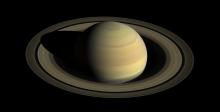Listen to today's episode of StarDate on the web the same day it airs in high-quality streaming audio without any extra ads or announcements. Choose a $8 one-month pass, or listen every day for a year for just $30.
You are here
Vernal Equinox
Those of us in the United States will wake up to a new season tomorrow. Spring begins at 5:29 a.m. Central Daylight Time — the moment of the vernal equinox. It occurs when the Sun crosses Earth’s equator from south to north. It ushers in longer, warmer days here in the northern hemisphere, and shorter, cooler days in the southern hemisphere.
Over the course of a year, the Sun moves north and south across the sky. That’s only an apparent motion, though. The Sun itself isn’t moving. Instead, that motion is caused by Earth’s tilt on its axis.
As seen from the Sun, Earth doesn’t stand straight up and down. Instead, it slouches — by about 23 degrees. As Earth moves around the Sun, that causes the north and south poles to nod toward and away from the Sun. In June, the north pole aims toward the Sun. That brings longer days to the northern hemisphere. And in December, it’s the south pole that nods sunward, bringing less daylight to northern climes.
The equinoxes come halfway between these extremes. Neither pole dips sunward, so both hemispheres experience roughly equal amounts of daylight and darkness. In fact, that’s where the name “equinox” comes from — it means “equal nights.”
The equinoxes are also the only times of year when the Sun rises due east and sets due west. Unless you’re on the equator, it rises north or south of those points for the rest of the year.
So enjoy the first day of spring — the start of a new season under the Sun.
Script by Damond Benningfield





